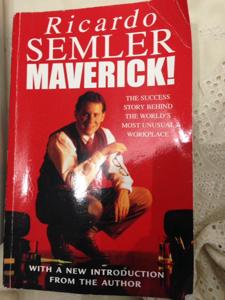
Want to learn the ideas in Maverick better than ever? Read the world’s #1 book summary of Maverick by Ricardo Semler here.
Read a brief 1-Page Summary or watch video summaries curated by our expert team. Note: this book guide is not affiliated with or endorsed by the publisher or author, and we always encourage you to purchase and read the full book.
Video Summaries of Maverick
We’ve scoured the Internet for the very best videos on Maverick, from high-quality videos summaries to interviews or commentary by Ricardo Semler.
1-Page Summary of Maverick
False Start
Thomas Watson was a successful salesman for National Cash Register at the age of 40. However, that turned out to be just a stepping stone in his career. In 1903, John H Patterson sent him to set up an anti-competitive company so he could destroy competitors and eventually have a monopoly or near-monopoly on cash registers. He did such an excellent job that he was promoted to sales manager of NCR in 1910 responsible for 200 branches and 900 salesmen.
Watson learned a lot from Patterson while at NCR. He was very strict, and Watson had to follow his rules. For example, he told employees how often they could bathe. His sales manual included verbatim pitches that the salesman should use when selling the machine to customers. As Watson became more familiar with running a business, he loosened some of these controls and let his men do things their own way. In fact, he formed a close friendship with Charles Kettering (who later founded Delco), who helped him understand how important R&D is for growing businesses as well as new products and services offered by those businesses. However, in 1912 an anti-trust lawsuit forced Watson out of NCR because it involved falsifying records about used cash registers sold to customers through other companies owned by NCR’s parent company National Cash Register Company (NCR). This incident taught him many lessons about honesty in business dealings and inspired him to become even more honest than before—as well as being careful not to break any laws or violate ethical practices in his future career endeavors.
The Real Career
Tom Watson Jr. was born in 1874 in New York City. He had a normal childhood until he turned 40, when he joined the Computing-Tabulating-Recording Company (C-T-R). The company was owned by Charles Ranlett Flint, who also owned several companies that made computing scales. Flint merged his holdings into C-T-R and hired Tom Watson to turn around the firm’s fortunes. Watson got 1,200 shares of stock and 5% of C-T-R’s net after taxes and dividends for his services as manager.
Flint’s job was challenging because of the terms he agreed to when buying Hollerith’s company. He had to keep Hollerith happy or else new product development would be stalled. Watson learned how to do this by massaging his ego and making him feel important.
Watson was a revolutionary in the field of management. He wanted employees to think and offer suggestions, so he encouraged teamwork and cooperation. Watson also emphasized that people should dress well enough for customers to respect them, but not too much as it would distract from their product. Although he didn’t make rules about drinking, most people at C-T-R did not drink around customers or meet with them after they had been drinking. It wasn’t considered safe to drink on one’s own time either.
C-T-R’s sales were $4.2 million when Watson joined in 1914. By 1920, they had more than tripled. Watson wanted to double performance again and so managers geared up production, laid in inventories and hired new staff just before a record recession hit the country. Watson cut salaries and people during this time but by 1922 times improved and stayed good through the rest of the decade as well for C-T-R machines grew in popularity but their technology was a bit dated compared to competitors such as Powers Accounting Machine Company who came up with a superior product that was faster and easier to use which made it difficult for C-T-R machines to compete against them until eventually Watson established an R&D lab at his company where he coddled engineers lavishing expensive trips, bonuses, stocks on them which resulted in hundreds of patents being developed over time helping him overcome competition from other companies leading him towards success once again after facing failure earlier on.





